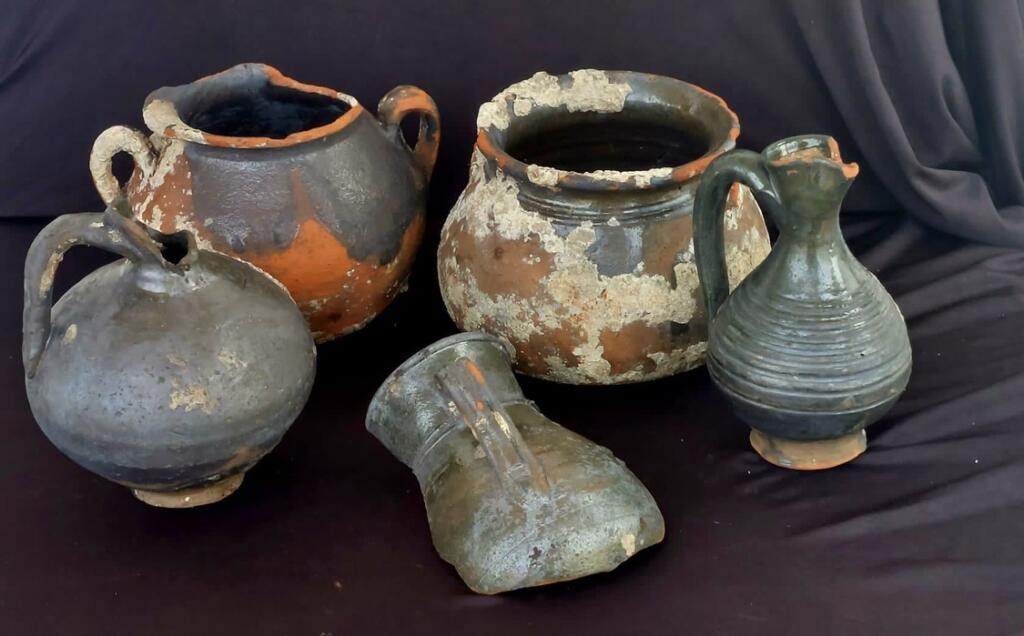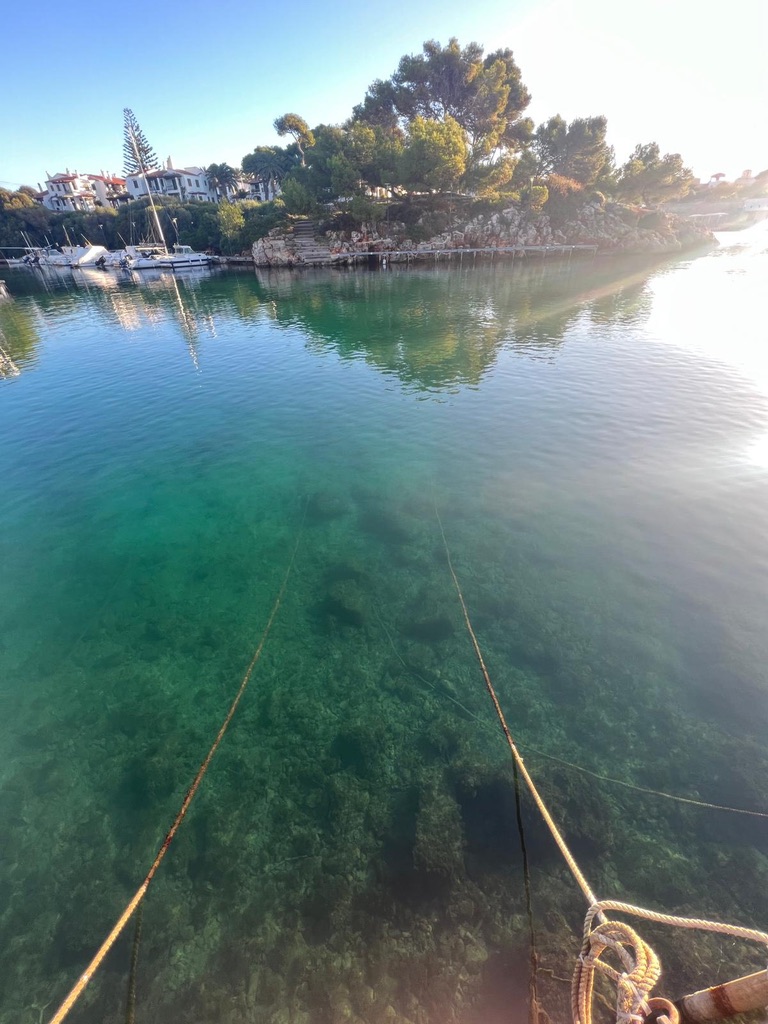Scuba diving was never my strong suit. I’ve always had difficulty clearing my ears, even in the deep end of a swimming pool. So I surprised myself when I signed up for a 10-day underwater adventure on the island of Menorca. It was November of 2023 and I had been fantasizing about circumnavigating the island on foot via the ancient “horse trail” called the Camí de Cavalls. Then my friend, Tim Weed, called me to consider enrolling in an underwater archeology field school with the Menorca Shipwreck Project. Tim knew the young man, Trevor Wallace, who was organizing the expedition. This was way out of my comfort zone and I had no illusions about finding buried treasure. But after a lot of hand wringing I opted in.
Menorca is an archaeological wonderland, above ground and underwater. It is the easternmost and second largest of the four Balearic Islands in the Mediterranean Sea, off of the Spanish coast near Valencia. Its history is one of continual conquest. Early humans, Phoenicians, Romans, Moors, Catalonians, English, Spanish all found their way to Menorca. Around every hillside and cove you find well-preserved efforts to transform an island of stone into human settlement. There are ancient domed structures called Taliots, field border walls, buildings and roads all made of stacked rocks. The islanders were renowned for their abilities to sling rocks with deadly accuracy and velocity. Historical accounts say they trained their children by forcing them to shoot their food out of the trees with sling shots.
Our field school class included Tim and his son, Tucker, herbalist, Sue Mullen, and me. We were headquartered in Ciutadella, a charming hilly city of about 25,000 and one of two primary ports on the island. After surviving a chilly three-day open water PADI scuba certification program, the field school began. Dives took place in Cala de Busquets, a sandy and fairly shallow harbor at the entrance of the port with a view of the silhouetted mountains of Mallorca directly to the west.
Shipwrecks have been common in Ciutadella for as long as humans have been sailing to these shores. Over many centuries, the harbor has been vulnerable to rissagas (literally “hangovers” in Catalonian). These are super low tides followed by crushing giant waves that sink ships and wreak havoc: technically meteotsunamis. Evidence of shipwrecks from various epochs — Roman, medieval, and 18th century — surfaced when archeological drill samples were required for harbor repairs. Trevor Wallace, Vice President of Research and Education at the New York-based Explorer’s Club, founded the Menorca Shipwreck Project with an international team of archaeologists including Xavier Aguelo, who was in charge of the initial archeological survey. Permits took years to acquire. An international team was assembled with all findings to be turned over to the archeology museum in Ciutadella.
The archeologists were straight out of central casting for an Indiana Jones movie. Fit, fun loving, with a facility for history and languages, they hailed from Spain, Switzerland, Siberia and the United States. It was a window into a tribe of historians who travel the globe searching for remnants of human settlement in swamps, on glaciers, on land and under water. Not plunderers or treasure seekers, but archeology geeks piecing together the scattered clues of humanity’s ancient past.
The project’s mission was to reveal as much of the carcass of a 300-year old ship as possible in a month’s time in order to prove that further exploration was justified. The vessel was thought to be the merchant ship Nuestra Señora de la Concepción, a trading ship out of Genoa that went down in December 1702. She lay beneath three feet of sand and a mat of native sea grass called posedonia. The underwater archeologists wanted to find out whether this was indeed the ship whose manifest reported it to be carrying textiles and mattresses, salt and esparto, goods which were regularly bought and sold along a well established western Mediterranean trading route.
Ciutadella’s harbor is a narrow channel, the walled city on one side, a marina on the other and a view of Mallorca through the harbor mouth. Offseason boat traffic was minimal. A temporary floating dock supported two Honda water pumps which powered the sand suction operation underwater. Given what we’d endured during cold, windy and deep certification dives, I almost opted out of the diving. But on our first day the team uncovered four intact pieces of pottery amidst the slowly emerging deck of the shipwreck. Within hours they were identified as artifacts dating from 1200 and 1700. Not knowing whether I would have another chance weather-wise, I took the plunge.
The harbor was just 15 feet deep. Reaching the work zone still required painfully equalizing the pressure in my ears. But once down at the wreck site I became quite comfortable. The work was physical, suctioning away a few inches of sand at a time and slowly digging a trench that would hopefully reveal the size and girth of the ship. Despite strong tides, I found I could balance and breathe calmly and do physical labor underwater. Every once in a while we swam away for a better view of the emerging deck planks of the ancient ship which no human had touched for centuries.
Dives took place in two hour shifts from 9 am to 2 pm followed by a late afternoon rendezvous at a local bar or archeology museum for an evening class. Nearly every staff member had an advanced degree and took turns presenting about the basics of underwater archeology, island history, modern 3-D photography tools, and ancient fire starting techniques. Truth be told you don’t learn much about archaeology without talking about pottery or how civilizations cared for their dead.
One evening we visited a library in Menorca’s twin port city of Mao to see for ourselves the ancient records of the Nuestra Señora de la Concepción. The historian wore disposable gloves to show us the 6-inch thick tome that included the hand written and notarized account of ownership, cargo, and salvage efforts as well as the costs related to storage and duties paid to the king for items recovered from the ship.
A storm was blowing from the west on the morning of our final dive. Waves belted the rocks with huge blasts of white spray. Visibility was limited. Our only goal that day was to bring to the surface the four ceramics pots which up to that time were the crowning discoveries of this year’s operation. Tucker and I were the lucky ones chosen along with the amazing husband and wife team of Carolina Sánchez and and Carlos Velasco to bring them up. Trevor documented the scene with his underwater photography gear. By now we had been diving for a week straight. But even with our increasing familiarity underwater I was still nervous. An anchor rope always seemed to catch me by surprise on my way back to the dock. We cradled each pot in two hands in teams of two and I handed it off to Carlos before we got the surface. It was important to submerge the artifacts immediately in water as exposure to the change in atmospheric pressure could cause them to disintegrate.
Tucker and I returned to our respective homes in Cairo and Valencia. Tim and Sue and the team kept working for a few days more. On his last day, Tim, who’d missed a number of dives because of illness, found a wooden bowl between the planks of the ship. The entire site was carefully documented with 3-D cast models, photographs and videos before it was covered with sand once again to prevent looting. Despite all the efforts of the first year of the Field School, it has not been definitively determined whether this in fact was the Nuestra Señora or the remains of another vessel.
There are things you do, places you go, times in your life that require more than you think you have to give. Things that leave you looking back in wonder, ready to return to your comfortable life, but hoping for a chance to return. You never know until you’ve been there and done it. This in itself is a reason to try.




